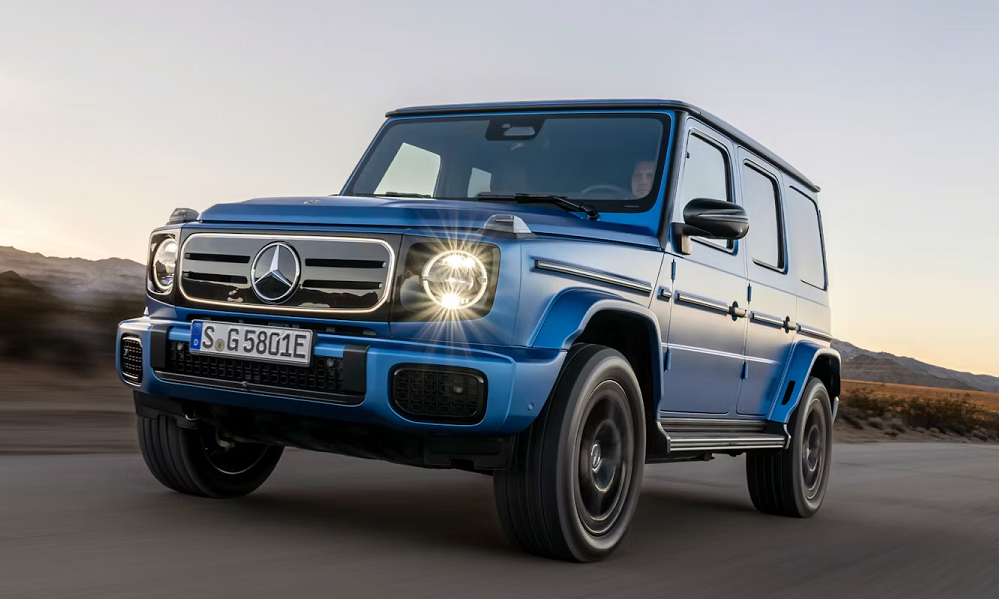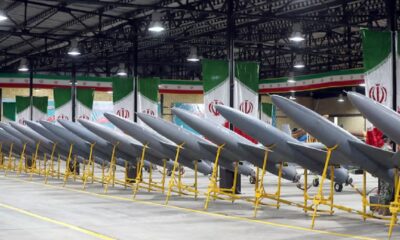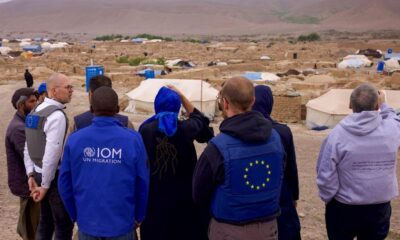Science & Technology
Putin aims to have Russian space station by 2027

President Vladimir Putin said on Thursday the first segment of Russia’s new orbital station, which Moscow sees as the next logical development in space exploration after the International Space Station (ISS), should be put into operation by 2027.
In a meeting with space industry officials, Putin also vowed to proceed with Russia’s lunar programme despite the failure in August of its first moonshot in 47 years, Russian news agencies reported, according to Reuters.
Putin said Moscow’s decision to extend to 2028 its participation in the ISS, now 25 years old, was a temporary measure.
“As the resources of the International Space Station run out, we need not just one segment, but the entire station to be brought into service,” Putin was quoted as saying of the new Russian orbital station.
“And in 2027, The first segment should be place in orbit.”
He said the development of the station had to proceed “all in good time” or the Russian programme risked falling behind in terms of the development of manned space flight.
The new station, he said, had to “consider all advanced achievements of science and technology and have the potential to take on the tasks of the future”.
Yuri Borisov, head of the Russian space agency, Roscosmos, endorsed Putin’s position as a means of maintaining the country’s capabilities in manned space flight.
“The ISS is getting old and will come to an end sometime around 2030,” Russian agencies quoted him as telling reporters.
“If we don’t start large-scale work on creating a Russian orbital station in 2024 it is quite likely that we will lose our capability because of the time gap. What I mean is the ISS will no longer be there and the Russian station won’t be ready.” In his remarks, Putin also said he had been informed fully about the technical mishaps that led to the crash landing of the Luna-25 craft in August on the moon’s south pole.
“We will of course be working on this. The lunar programme will continue. There are no plans to close it,” Putin said.
“Mistakes are mistakes. It is a shame for all of us. This is space exploration and everyone understands that. It is experience that we can use in the future.”
Borisov said the next moon launch might be moved forward to 2026 from 2027 as now planned.
Science & Technology
Mercedes Benz unveils electric G-class at Beijing Auto Show

Mercedes Benz has chosen China, its largest market, to unveil its groundbreaking pure electric vehicle and advance its electrification strategy.
Markus Schafer, Mercedes Chief Technology Officer (CTO), said the company was dedicated to making more sustainable products.
He stressed the sheer size of the Chinese market as its reason for choosing the ongoing Beijing Auto Show for the debut showcase of its electrified G-class 4×4 SUV.
“China is our biggest market, our most important market. And secondly, Mercedes decided to go all electric with our fleet going into the next years and [it’s] very, very important to provide customers access to an electric G wagon next to the combustion engine cart, so this is an iconic model, very important for the company. And we are so pleased to offer it now electrically,” said Schafer.
The CTO said Mercedes Benz plans to increase its investment in China by expanding crucial Research and Development activities.
Science & Technology
Apple loses top phonemaker spot to Samsung as iPhone shipments drop, IDC says

Apple’s (AAPL.O), opens new tab smartphone shipments dropped about 10% in the first quarter of 2024, hurt by intensifying competition by Android smartphone makers aiming for the top spot, data from research firm IDC showed on Sunday.
Global smartphone shipments increased 7.8% to 289.4 million units during January-March, with Samsung (005930.KS), opens new tab, at 20.8% market share, clinching the top phonemaker spot from Apple, Reuters reported.
The iPhone-maker’s steep sales decline comes after its strong performance in the December quarter when it overtook Samsung as the world’s No.1 phone maker. It’s back to the second spot, with 17.3% market share, as Chinese brands such as Huawei gain market share.
Xiaomi, one of China’s top smartphone makers, occupied the third position with a market share of 14.1% during the first quarter, read the report.
South Korea’s Samsung, which launched its latest flagship smartphone lineup – Galaxy S24 series – in the beginning of the year, shipped more than 60 million phones during the period.
Global sales of Galaxy S24 smartphones jumped 8%, compared to last year’s Galaxy S23 series during their first three weeks of availability, data provider Counterpoint previously said.
In the first quarter, Apple shipped 50.1 million iPhones, down from 55.4 million units it shipped same period last year, according to IDC.
Apple’s smartphone shipments in China shrank 2.1% in the final quarter of 2023 from a year earlier.
The drop underscores the challenges facing the U.S. firm in its third biggest market, as some Chinese companies and government agencies limit employees’ use of Apple devices, a measure that mirrors U.S. government restrictions on Chinese apps on security grounds.
The Cupertino, California-based company in June will hold its Worldwide Developers Conference (WWDC), where it will highlight updates to the software powering iPhones, iPads, and other Apple devices.
Investors are closely watching for updates on artificial intelligence development at Apple, which has so far spoken little about incorporating the AI technology into its devices. The company earlier this year lost the crown as the world’s most valuable company to Microsoft (MSFT.O), opens new tab, Reuters reported.
Science & Technology
China launch of relay satellite Queqiao-2 for lunar probe mission successful

China National Space Administration (CNSA) said on Friday its launch of a key signal relay satellite was a “complete success” and it would serve as the communication bridge for its future lunar probe missions for years to come, state media reported.
China launched the satellite Queqiao-2, which was named after a mythological bridge made of magpies, and two miniature satellites, Tiandu-1 and Tiandu-2, on March 20.
Queqiao-2 will be used as a communications bridge between the ground operations on earth and upcoming lunar probe missions on the far side of the moon until at least 2030.
The moon’s near side always faces earth. That means data transfers from the far side are impossible because there is no direct line of sight.
Queqiao-2 researcher and developer Xiong Liang described the satellite as “the main switch” of the whole fourth phase of lunar missions, according to state television CCTV.
“Only when the main switch is flipped on, all the communications can kick off,” Xiong said.
Queqiao-2 will orbit the moon and relay signals to and from the Chang’e-6 mission, which expected to be launched in May. The robotic Chang’e-6 probe will seek to retrieve samples from an ancient basin, acquiring lunar material from the moon’s hidden side for the first time.
Queqiao-2 will also be used as a relay platform for the Chang’e-7 lunar mission in 2026 and the Chang’e-8 mission in 2028.
The functions and performance of Queqiao-2 met mission requirements and it will be able to provide relay communication services for China’s lunar exploration projects and future lunar missions for China and other countries, said the CNSA, according to CCTV.
Queqiao-2 entered its targeted elliptical orbit on April 2 after a correction midway, near-moon braking and orbital manoeuvre around the moon, CNSA said.
The satellite has successfully communicated with Chang’e 4, which was the first spacecraft to perform a soft landing on the far side of the moon and is still carrying out its exploration mission. It also communicated with the Chang’e-6 probe while it is still on the ground earlier this month.
The successful launch of Queqiao-2 comes after the failed launch of another lunar spacecraft DRO-A/B satellites, which was intended to enter the moon’s distant retrograde orbit (DRO).
China has not released any information on whether or not the satellites can be retrieved.
(Reuters)
-

 Sport4 days ago
Sport4 days agoAfghanistan beat Iraq 5-3, inch closer to Futsal World Cup berth
-

 Regional4 days ago
Regional4 days agoNew UK sanctions target Iranian drone industry
-

 Latest News4 days ago
Latest News4 days agoEU allocates 17 million euros to support Afghans on the move
-

 Latest News3 days ago
Latest News3 days agoPakistan extends registered Afghan refugees’ stay till June 30
-

 World5 days ago
World5 days agoUS student protests over Gaza intensify despite arrests
-

 Regional3 days ago
Regional3 days agoChina to host Hamas, Fatah for Palestinian unity talks
-

 Sport2 days ago
Sport2 days agoAfghanistan qualify for FIFA Futsal World Cup for first time ever
-

 Latest News4 days ago
Latest News4 days agoTripartite trade meeting held in Kabul to boost regional connectivity


























